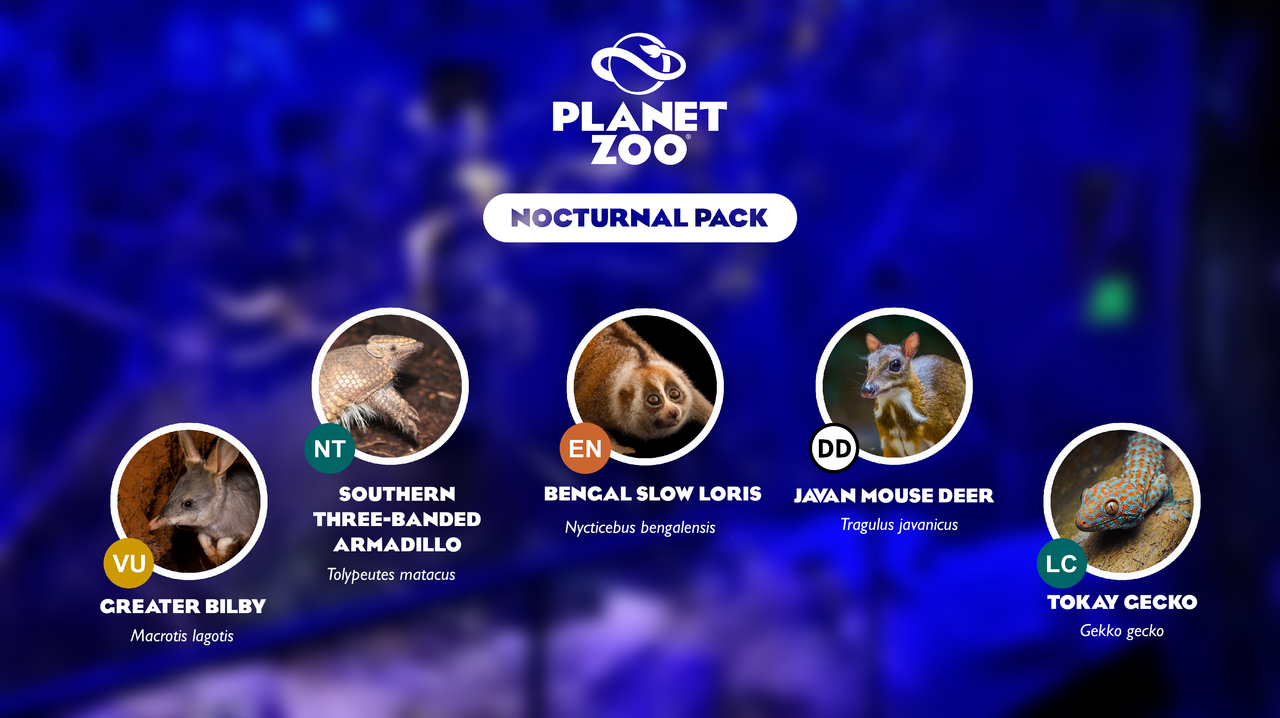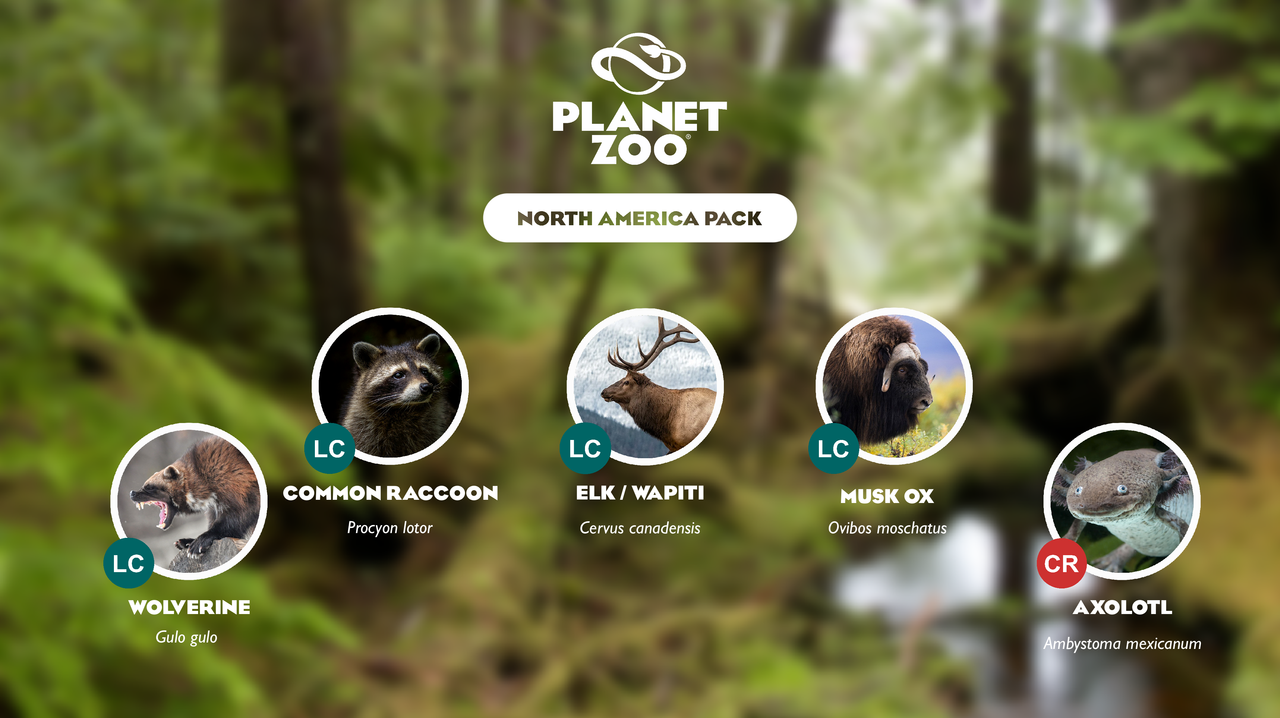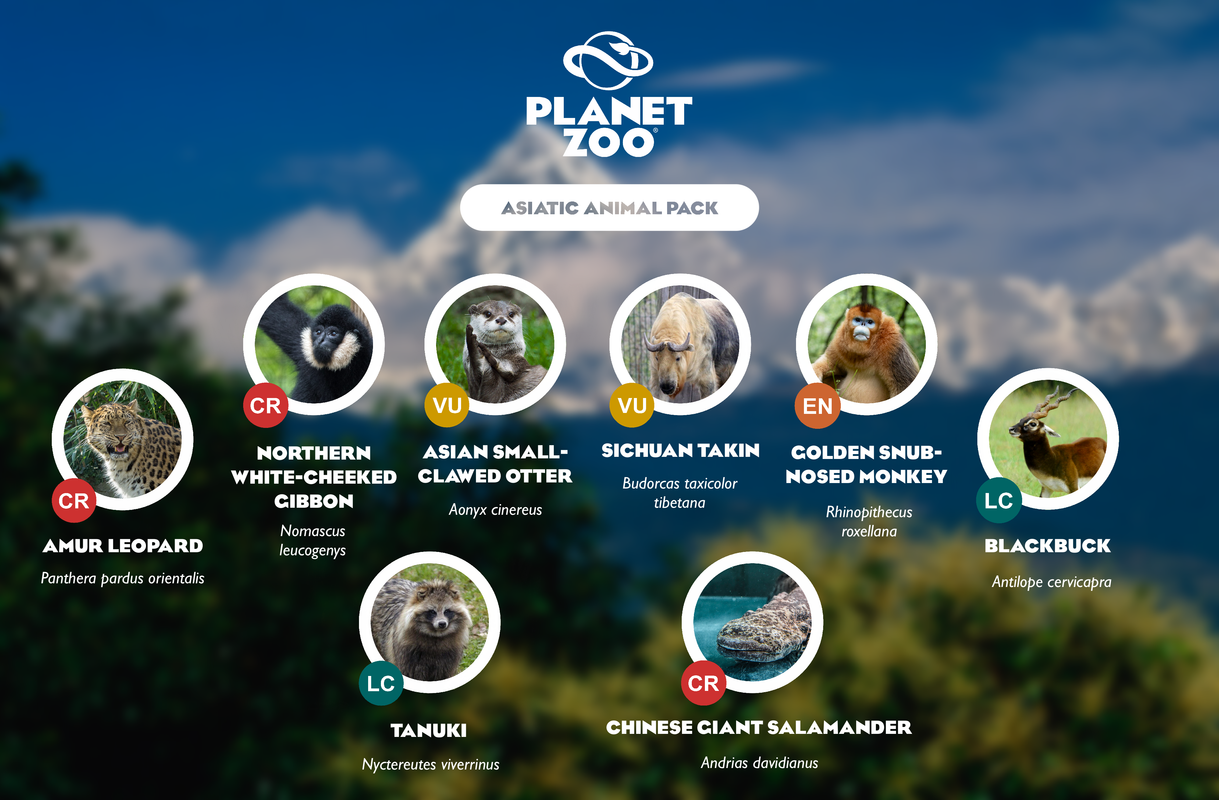Hi all! Over the past few weeks I've been spending lots of time speculating on Planet Zoo's future DLC and potential packs that could be released. I thought I'd share them here and use this thread as a repository for my various ideas. All pack concepts will include a graphic of the roster (made by me) alongside some explanations on the pack's items and animals.
So, let's begin with the Nocturnal Pack:

The Nocturnal Pack would be a DLC focused around adding small animals commonly found in Nocturnal Houses. I decided to go with a Standard Pack for this DLC, mainly to justify the inclusion of various scenery items. Things such as blacklights, dark room walls, scenery for small exhibits, various backstage items and more could be incredibly useful tools for builders. Unique enrichment for small arboreal animals, such as hanging arboreal nests, would also be a welcome addition.
Nocturnal behavior (reversed sleep cycle, enrichment from nocturnal lighting, etc.) would be added for the following animals:
Greater Bilby: The Greater Bilby, while solely present in Australian collections, feels like a vital animal to me. Distinct, iconic, and an Australian Easter icon, including it in the Nocturnal Pack allows one of the most widely kept animals in Australian nocturnal houses to be featured in Planet Zoo.
Southern Three-Banded Armadillo: A xenarthran for this pack also seemed reasonable, given their nocturnal behavior. The choice to pick a Three-Banded Armadillo over a Nine-Banded Armadillo was mainly personal preference. The three-banded is, to my knowledge, more widely kept in captivity, and would offer a unique behavioral quirk with its ability to properly roll into a ball.
Bengal Slow Loris: I debated this spot for a while; I couldn't decide if it should go to the Aye-Aye, an Owl Monket, or a Slow Loris. I opted for a loris in the end since both lemurs and New World monkeys are already present in game, on top of the conservation importance of the Slow Loris. Initially I was going to pick the Pygmy Slow Loris, but a friend pointed out that it was most likely too small for PZ, and the Bengal Slow Loris was also frequently kept in zoos.
Javan Mouse Deer: The Javan Mouse Deer was chosen to add some Tragulid representation to the roster. The Javan species is the most common in captivity, and offers a unique (and adorable) small ungulate to zoo builders.
Tokay Gecko: A gecko for this pack felt like a no-brainer. They're one of the most highly requested exhibit animals besides chameleons, and since most geckos are nocturnal, a night house DLC is the perfect opportunity to include them. The Tokay Gecko was chosen mainly because it's one of the more iconic and large gecko species.
Let me know what you think! I've currently got three other DLC fully formulated alongside a selection of possibly update animals, all of which will be coming soon. I'll gladly accept suggestions for possible DLC packs to conceptualize as well. Many thanks to Chuditch for helping me iron out these ideas. Next up, we'll be returning to an already recently represented region to cap off its roster.
(EDIT: Added a list of currently in-game animals to be given nocturnal behavior.)
So, let's begin with the Nocturnal Pack:

The Nocturnal Pack would be a DLC focused around adding small animals commonly found in Nocturnal Houses. I decided to go with a Standard Pack for this DLC, mainly to justify the inclusion of various scenery items. Things such as blacklights, dark room walls, scenery for small exhibits, various backstage items and more could be incredibly useful tools for builders. Unique enrichment for small arboreal animals, such as hanging arboreal nests, would also be a welcome addition.
Nocturnal behavior (reversed sleep cycle, enrichment from nocturnal lighting, etc.) would be added for the following animals:
- Aardvark
- Binturong
- Clouded Leopard
- Chinese Pangolin
- Cuvier's Dwarf Caiman
- Fennec Fox
- European Badger
Greater Bilby: The Greater Bilby, while solely present in Australian collections, feels like a vital animal to me. Distinct, iconic, and an Australian Easter icon, including it in the Nocturnal Pack allows one of the most widely kept animals in Australian nocturnal houses to be featured in Planet Zoo.
Southern Three-Banded Armadillo: A xenarthran for this pack also seemed reasonable, given their nocturnal behavior. The choice to pick a Three-Banded Armadillo over a Nine-Banded Armadillo was mainly personal preference. The three-banded is, to my knowledge, more widely kept in captivity, and would offer a unique behavioral quirk with its ability to properly roll into a ball.
Bengal Slow Loris: I debated this spot for a while; I couldn't decide if it should go to the Aye-Aye, an Owl Monket, or a Slow Loris. I opted for a loris in the end since both lemurs and New World monkeys are already present in game, on top of the conservation importance of the Slow Loris. Initially I was going to pick the Pygmy Slow Loris, but a friend pointed out that it was most likely too small for PZ, and the Bengal Slow Loris was also frequently kept in zoos.
Javan Mouse Deer: The Javan Mouse Deer was chosen to add some Tragulid representation to the roster. The Javan species is the most common in captivity, and offers a unique (and adorable) small ungulate to zoo builders.
Tokay Gecko: A gecko for this pack felt like a no-brainer. They're one of the most highly requested exhibit animals besides chameleons, and since most geckos are nocturnal, a night house DLC is the perfect opportunity to include them. The Tokay Gecko was chosen mainly because it's one of the more iconic and large gecko species.
Let me know what you think! I've currently got three other DLC fully formulated alongside a selection of possibly update animals, all of which will be coming soon. I'll gladly accept suggestions for possible DLC packs to conceptualize as well. Many thanks to Chuditch for helping me iron out these ideas. Next up, we'll be returning to an already recently represented region to cap off its roster.
(EDIT: Added a list of currently in-game animals to be given nocturnal behavior.)
Last edited:



